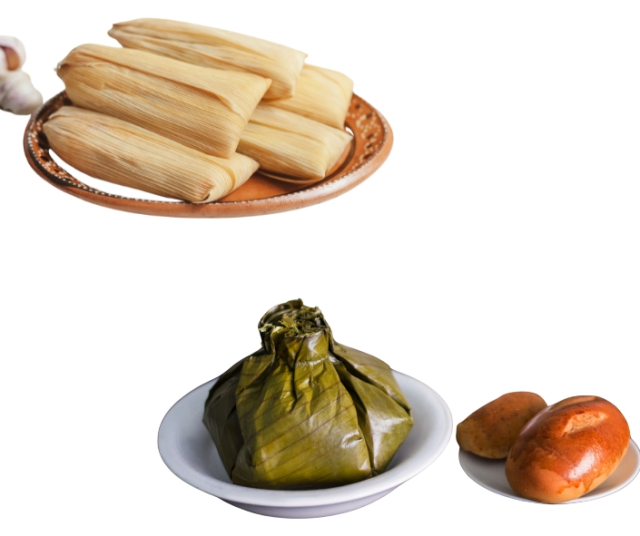Tamales are a delicious and ancient culinary tradition that has endured throughout the centuries in different cultures in Latin America. Each country has its own variant of this dish, and Mexico and Colombia are no exception. Although they both share a love for tamales, there are notable differences in their preparations, ingredients and flavors.
History of Tamales: A Look at the Cultural Roots
Before delving into the specific differences, it is crucial to understand the history of tamales in Mexico and Colombia. Both nations have deep indigenous roots that have significantly influenced their respective cuisines.
Mexican Tamales: Pre-Columbian Tradition
In Mexico, tamales have a history dating back to ancient pre-Columbian civilizations, such as the Aztecs and Mayans. These native peoples used corn as the main ingredient to make a wide variety of dishes, and tamales were an essential part of their diet. The tradition of wrapping food in corn husks and steaming it has been passed down from generation to generation.
Colombian Tamales: Fusing Indigenous and Spanish Cultures
In Colombia, the history of tamales is a fusion of indigenous and Spanish traditions. The arrival of the Spanish conquistadors introduced new ingredients and cooking techniques, merging with native customs. The result was a varied range of dishes, including tamales, that incorporated indigenous and Spanish elements.
Key Ingredients: The Essence of Tamales
One of the highlights when comparing Mexican and Colombian tamales is the diversity of ingredients used in each region. Although they share some similarities, differences in fundamental components result in unique flavors.
Ingredients of Mexican Tamales: Corn, Sauces and Various Fillings
Mexican tamales often use corn masa as a base. This dough is mixed with butter, chicken or beef broth, and seasoned with herbs and spices. Fillings can include pork, chicken, chiles, and beans, among others. Sauces play a crucial role; Mole, a rich blend of chiles and chocolate, is emblematic of some Mexican tamales.
Ingredients of Colombian Tamales: Corn, Potatoes and Caribbean Seasonings
In Colombia, corn dough is also the protagonist, but it is differentiated by the addition of potato, which gives it a unique texture. Colombian tamales incorporate ingredients such as pork, chicken, rice, chickpeas and egg. What makes Colombian tamales distinctive is the use of Caribbean seasonings, such as annatto, turmeric and cumin, which add a touch of color and characteristic flavor.
Forms and Presentations: Creativity in Presentation
Another notable difference between Mexican and Colombian tamales lies in the way they are presented and served. Each country has its own traditions regarding the presentation of this emblematic dish.
Presentation of Mexican Tamales: Corn Leaves and Variety of Shapes
In Mexico, tamales are wrapped in corn husks, and the shape of these can vary depending on the region. Some are long and thin, known as "corundas", while others are smaller and rounder. The diversity of forms reflects the rich cultural variety of the country.
Presentation of Colombian Tamales: Banana Leaves and Tied with Rope
In Colombia, tamales are wrapped in banana leaves and tied with string before being steamed. This presentation gives a unique flavor and characteristic aroma to the tamales. In addition, the square shape is common in some places, marking a stylistic difference with Mexican tamales.
Cooking Techniques: From Steam to the Oven
Cooking techniques also contribute to the differences between Mexican and Colombian tamales. Although both are steamed, there are variations in preparation methods that affect the final texture and flavor.
Cooking Mexican Tamales: Steam and Traditional Ovens
In Mexico, tamales are primarily steamed. However, in some regions, they are also baked. This combination of techniques results in a soft texture on the inside and, in the case of baked tamales, a slightly crunchy coating on the outside.
Cooking Colombian Tamales: Slow Steam for a Juicy Texture
In Colombia, steam cooking is the main technique, and it is done over low heat for several hours. This process contributes to a juicy and tender texture in Colombian tamales. Patience in cooking is a distinctive characteristic that is reflected in the softness of the final product.
Celebrations and Special Events: Tamales as a Cultural Symbol
In both Mexico and Colombia, tamales are much more than just a dish for everyday enjoyment; They are an integral part of celebrations and special events, each with their own traditions and meanings.
Tamales in Mexican Celebrations: From the Posadas to the Day of the Dead Festival
In Mexico, tamales are inseparable from festivities such as the Christmas Posadas and the Day of the Dead Festival. In these celebrations, families gather to prepare large quantities of tamales, sharing stories and traditions while enjoying this delicious food.
Tamales in Colombian Celebrations: Christmas and Special Family Occasions
In Colombia, tamales are a fundamental element of Christmas celebrations. The preparation of tamales becomes a family event, where generations come together to share techniques and recipes passed down over time. Tamales are considered a symbol of family unity and love.
Both versions share the essence of Latin American culture: the importance of family, shared celebrations and the passion for cooking. As we explore the differences between Mexican and Colombian tamales, we discover a rich and complex culinary world that transcends geographic boundaries, reminding us that food is a bridge that unites people across time and space.
